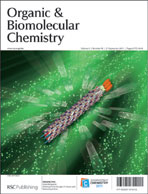Molecular design, chemical synthesis, and biological evaluation of agents that selectively photo-degrade the transcription factor estrogen receptor-α†
Abstract
2-Phenylquinoline (1) degraded proteins under photo-irradiation with long-wavelength UV light without additives and under neutral conditions. We designed and synthesized a 2-phenylquinoline-estrogen receptor-α (ER-α) agonist (hybrid 2) and a 2-phenylquinoline-ER-α antagonist (hybrid 3) containing estradiol and 4-hydroxytamoxifen moieties, respectively. These 2-phenylquinoline hybrids effectively and selectively photo-degraded the target transcription factor, ER-α, which has a high affinity for estradiol and 4-hydroxytamoxifen. Target-selective photo-degradation was examined in both glass vessels and MCF-7 breast cancer cells, which are dependent upon ER-α for growth. In addition, 2-phenylquinoline-estradiol hybrid 2 functioned as an agonist of ER-α and promoted growth of MCF-7 in the absence of photo-irradiation, while it inhibited the growth of MCF-7 cells upon photo-irradiation due to the photo-degradation of ER-α. In contrast, 2-phenylquinoline-4-hydroxytamoxifen hybrid 3 inhibited growth of MCF-7 cells in the absence of photo-irradiation due to the antagonist effect of the 4-hydroxytamoxifen moiety against ER-α, and upon photo-irradiation significantly inhibited cell growth due to the dual antagonist effect of the 4-hydroxytamoxifen moiety and photo-degradation of ER-α.


 Please wait while we load your content...
Please wait while we load your content...